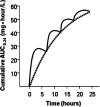Pharmacokinetics-pharmacodynamics of gatifloxacin in a lethal murine Bacillus anthracis inhalation infection model
- PMID: 17875992
- PMCID: PMC2167989
- DOI: 10.1128/AAC.00251-07
Pharmacokinetics-pharmacodynamics of gatifloxacin in a lethal murine Bacillus anthracis inhalation infection model
Abstract
We determined the pharmacokinetic-pharmacodynamic (PK-PD) measure most predictive of gatifloxacin efficacy and the magnitude of this measure necessary for survival in a murine Bacillus anthracis inhalation infection model. We then used population pharmacokinetic models for gatifloxacin and simulation to identify dosing regimens with high probabilities of attaining exposures likely to be efficacious in adults and children. In this work, 6- to 8-week-old nonneutropenic female BALB/c mice received aerosol challenges of 50 to 75 50% lethal doses of B. anthracis (Ames strain, for which the gatifloxacin MIC is 0.125 mg/liter). Gatifloxacin was administered at 6- or 8-h intervals beginning 24 h postchallenge for 21 days, and dosing was designed to produce profiles mimicking fractionated concentration-time profiles for humans. Mice were evaluated daily for survival. Hill-type models were fitted to survival data. To identify potentially effective dosing regimens, adult and pediatric population pharmacokinetic models for gatifloxacin and Monte Carlo simulation were used to generate 5,000 individual patient exposure estimates. The ratio of the area under the concentration-time curve from 0 to 24 h (AUC(0-24)) to the MIC of the drug for the organism (AUC(0-24)/MIC ratio) was the PK-PD measure most predictive of survival (R(2) = 0.96). The 50% effective dose (ED(50)) and the ED(90) and ED(99) corresponded to AUC(0-24)/MIC ratios of 11.5, 15.8, and 30, respectively, where the maximum effect was 97% survival. Simulation results indicate that a daily gatifloxacin dose of 400 mg for adults and 10 mg/kg of body weight for children gives a 100% probability of attaining the PK-PD target (ED(99)). Sensitivity analyses suggest that the probability of PK-PD target attainment in adults and children is not affected by increases in MICs for strains of B. anthracis to levels as high as 0.5 mg/liter.
Figures



Similar articles
-
Pharmacokinetic-pharmacodynamic assessment of faropenem in a lethal murine Bacillus anthracis inhalation postexposure prophylaxis model.Antimicrob Agents Chemother. 2010 May;54(5):1678-83. doi: 10.1128/AAC.00737-08. Epub 2010 Feb 9. Antimicrob Agents Chemother. 2010. PMID: 20145081 Free PMC article.
-
Comparison of gatifloxacin and levofloxacin administered at various dosing regimens to hospitalised patients with community-acquired pneumonia: pharmacodynamic target attainment study using North American surveillance data for Streptococcus pneumoniae.Int J Antimicrob Agents. 2005 Aug;26(2):120-5. doi: 10.1016/j.ijantimicag.2005.04.012. Int J Antimicrob Agents. 2005. PMID: 16046101
-
Pharmacokinetic-pharmacodynamic analysis of fluoroquinolones against Bacillus anthracis.J Infect Chemother. 2004 Apr;10(2):97-100. doi: 10.1007/s10156-004-0303-9. J Infect Chemother. 2004. PMID: 15160302
-
Clinical implications of pharmacokinetics and pharmacodynamics of fluoroquinolones.Clin Infect Dis. 2005 Jul 15;41 Suppl 2:S127-35. doi: 10.1086/428053. Clin Infect Dis. 2005. PMID: 15942879 Review.
-
Challenges in assessing microbial susceptibility and predicting clinical response to newer-generation fluoroquinolones.J Ocul Pharmacol Ther. 2012 Feb;28(1):3-11. doi: 10.1089/jop.2011.0072. Epub 2011 Oct 14. J Ocul Pharmacol Ther. 2012. PMID: 21999341 Review.
Cited by
-
Activity of dalbavancin against Bacillus anthracis in vitro and in a mouse inhalation anthrax model.Antimicrob Agents Chemother. 2010 Mar;54(3):991-6. doi: 10.1128/AAC.00820-09. Epub 2010 Jan 4. Antimicrob Agents Chemother. 2010. PMID: 20047912 Free PMC article.
-
Use of an in vitro pharmacodynamic model to derive a moxifloxacin regimen that optimizes kill of Yersinia pestis and prevents emergence of resistance.Antimicrob Agents Chemother. 2011 Feb;55(2):822-30. doi: 10.1128/AAC.00818-10. Epub 2010 Nov 29. Antimicrob Agents Chemother. 2011. PMID: 21115791 Free PMC article.
-
White Paper: Developing Antimicrobial Drugs for Resistant Pathogens, Narrow-Spectrum Indications, and Unmet Needs.J Infect Dis. 2017 Jul 15;216(2):228-236. doi: 10.1093/infdis/jix211. J Infect Dis. 2017. PMID: 28475768 Free PMC article. Review.
-
Pharmacokinetic-pharmacodynamic assessment of faropenem in a lethal murine Bacillus anthracis inhalation postexposure prophylaxis model.Antimicrob Agents Chemother. 2010 May;54(5):1678-83. doi: 10.1128/AAC.00737-08. Epub 2010 Feb 9. Antimicrob Agents Chemother. 2010. PMID: 20145081 Free PMC article.
-
Protection Afforded by Fluoroquinolones in Animal Models of Respiratory Infections with Bacillus anthracis, Yersinia pestis, and Francisella tularensis.Open Microbiol J. 2010 Jun 3;4:34-46. doi: 10.2174/1874285801004010034. Open Microbiol J. 2010. PMID: 21127743 Free PMC article.
References
-
- Akaike, H. 1974. A new look at the statistical model identification. IEEE Trans. Automatic Control 19:716-723.
-
- Ambrose, P. G., S. M. Bhavnani, C. M. Rubino, A. Louie, T. Gumbo, A. Forrest, and G. L. Drusano. 2007. Pharmacokinetics-pharmacodynamics of antimicrobial therapy: it's not just for mice anymore. Clin. Infect. Dis. 44:79-86. - PubMed
Publication types
MeSH terms
Substances
Grants and funding
LinkOut - more resources
Full Text Sources
Medical

